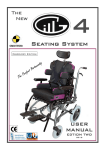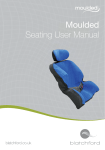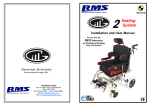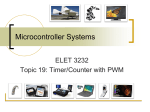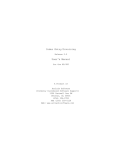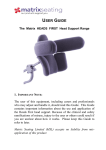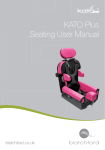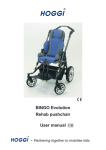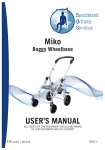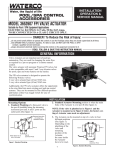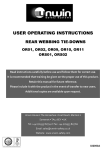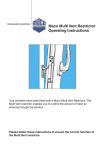Download Simba User Manual
Transcript
USER MANUAL Edition 2 2014 CONTENTS Safety guidelines Transportation Unfolding and folding Tilt—in—space operation Seat depth and pelvic support adjustment Footrest adjustment Fitting optional accessories Anklesure foot control devices Abductor Back extender Lateral supports Harness Ventilator tray/oxygen cylinder carrier Shopping basket Upholstery cleaning and care Product maintenance Inspection record Warranty statement Technical data SAFETY GUIDELINES For correct support and user comfort, it is strongly recommended that the initial installation, any adjustments and final hand-over are carried out by a suitably qualified person. Hand-over should include passing these instructions to the carer. A stability test with the intended user may be necessary prior to final issue. After the buggy has been adjusted to suit the intended user, any settings should not be affected when folding of the buggy. However, care should be taken not to impact adjustable components whilst folding or in the folded position. It is recommended that the user be checked at regular intervals by a suitably qualified person to ensure that adjustable components are correctly set to suit the user’s current requirements. It is recommended that any postural belts or harnesses being used are the first items to be secured when the user enters the seat and the last items to be released before exiting. Regular inspections of the buggy should be made and any defects reported to the relevant authority for rectification as soon as possible. The buggy parking brakes should always be applied before attempting to transfer the occupant or when making any adjustments. Never leave the buggy parked on a slope with the occupant seated. Heavy objects should never be suspended from the buggy push handle, as this could seriously affect the overall stability. It is recommended that to ensure maximum comfort and correct support, any adjustments affecting the user’s postural positioning should be carried out by a suitably qualified person. NOTE: Any reference to Left or Right in this manual will refer to the Left or Right side when sitting in the buggy. TRANSPORTATION The SIMBA Buggy has been successfully tested to ISO 7176-19 (Wheeled mobility devices for use in Motor Vehicles) The restraint systems used for the buggy and occupant during the above testing are available from:- Unwin Safety Systems. C.N. Unwin Ltd., Unwin House, The Horseshoe, Coat Road, Martock, Somerset, TA12 6EY. Tel: 01935 827740 Fax: 01935 827760 Email: [email protected] Web: www.unwin-safety.com Part numbers:Buggy tie-downs: Front—OF03 Rear—OR02 Occupant restraints: OCR02 These kits meet the requirements of ISO 10542 (Wheelchair Tie-downs and Occupant Restraint Systems). If the intended transporting vehicle is not already fitted with Unwin type anchorage tracks, details of these can also be obtained direct from Unwin Safety Systems Ltd. NOTE: Installation and use of all restraint systems should always be strictly as per the their manufacturers recommendations. The Buggy restraints must only be attached to the indicated tie-down points shown below. IMPORTANT NOTE: THE SIMBA and OCCUPANT MUST ONLY BE TRANSPORTED IN THE FORWARD FACING, FULLY UPRIGHT POSITION. Front Tie-down points Rear Tie-down points UNFOLDING the SIMBA Buggy After carefully removing the buggy from its container and with the parking brakes still applied, unfold the buggy as shown below in steps 1, 2 and 3 below. Step 3 Step 2 Step 1 Lock pins are engaged when both lock handles are on RED lines. NOTE: With the buggy fully unfolded, the seat locking mechanism is designed to automatically engage. This can be confirmed by checking that both lock handles are on the RED lock lines as shown and by lightly rocking the push handle backwards and forwards. BRAKE PEDAL OPERATION BRAKE ON BRAKE OFF FOLDING the SIMBA Buggy Before folding the buggy, apply the parking brake and fold the footrest upwards against its support panel. Whilst holding the push handle, release the seat locking mechanism by compressing both seat lock handles together, then push the push handle forwards until the Buggy folds down flat. The push handle may also be folded downwards against the backrest if required. TILT-IN-SPACE OPERATION The push handle mounted tilt release control enables convenient and easy operation of the seat tilt to the required position. To re-position the seat, operate the lever and either push down or raise the push handle until the required amount of tilt is achieved, then release the lever to lock the seat in position. Tilt release control It may also be necessary to re-adjust the push handle height after setting the tilt angle. To adjust the push handle height, depress both red locking buttons simultaneously to allow the push handle to be raised or lowered as required. SEAT DEPTH and PELVIC SUPPORT ADJUSTMENT Tools Required: 5mm Hexagon Key. Detach and remove the seat cushion. Raise the footrest and seat panel as an assembly to gain access to the underside of the seat. Slacken all four screws just sufficient to be able to reposition the upper seat panel. Check the pelvic support positions and reposition as required before retightening all four securing screws sufficient to prevent any movement. Replace the seat cushion. Seat panel and pelvic support securing screws. Seat panel and pelvic support securing key washers. FOOTREST ADJUSTMENT Tools Required: 4mm Hexagon Key and 10mm Spanner Slacken both footrest height adjustment screw lock nuts, located at the rear of the footrest support panel, then slacken both screws. Raise or lower the footrest to the required position, then retighten both screws and lock nuts sufficient to prevent any movement. Footrest height adjustment screws. FITTING OPTIONAL ACCESSORIES ANKLESURE FOOT CONTROL DEVICES Supplied with screws and fixings. Tools Required: 4mm Hexagon Key and 8mm Spanner The buggy footrest is pre-drilled to enable the fitting kit to be directly attached using the screws, nuts and washers supplied. The Anklesures should be attached to the bridges as shown below and adjusted to suit the user. (Velcro style fastening shown). Further adjustments may be necessary depending on the user’s growth or changes in foot-ware. Anklesure bridges (ABDUCTOR) Supplied with screws and fixings. Tools Required: 5mm Hexagon Key and 10mm Spanner. Locate the two pre-drilled mounting holes at the front of the seat panel. Using the fixings supplied in the kit, attach the mount to the buggy seat and tighten sufficient to prevent any movement. To insert the abductor, depress the pop-pin and push downwards until the pin locks at the bottom of the mount. To remove the abductor, depress the pop-pin and lift clear. Front Pop-pin BACK EXTENDER Supplied with screws and fixings. Tools Required: 4mm Hexagon Key. Unfasten the top of the backrest upholstery and temporarily fold forwards. This will expose two mounting holes at the top of the backrest panel. Insert the screws and plain washers supplied through the mounting holes from the rear. Install the threaded key washers loosely onto the screws with the largest face towards the front and the keys vertical. Re-fold backrest upholstery over the backrest, but do not re-attach to the Velcro panels at this stage. Slide the back extender downwards through the pre-formed slot in the backrest upholstery then down the front face of the backrest panel until the slots in the back extender fully engage onto the key washers. With the back extender correctly engaged, finally tighten both screws sufficient to prevent any movement. Ensure both the cover tab shown below and the tab on the front of the back extender cover are located over the key washers before re-attaching the backrest upholstery. Key nuts Cover Tab Insert back extender through pre-formed slot in backrest upholstery LATERAL SUPPORTS Supplied with screws and fixings. Tools Required: 4mm Hexagon Key. NOTES: 1/ The lateral supports are supplied complete with screws and fixings. 2/ The lateral supports are handed by virtue of a small recess in the rear of each side support pad panel. This recess is to assist with retaining the pad and should always be located at the top. Separate the upholstery at the rear of the backrest to gain access to the mounting slots in the backrest panel. Install the lateral supports one at a time by inserting each support, with the recess at the top, through the relevant slot in the backrest upholstery from the front. Using the screws and washers provided insert these from the rear of the backrest panel, then through into the threaded key washers which should be located in the mounting slots at the front of the supports. Position the lateral supports to suit the user’s requirements and finally secure sufficiently to prevent any movement. Backrest upholstery slotted to take lateral supports Mounting screws with large washers Lateral support mounting slots HARNESS Supplied with screws and fixings. Tools Required: Sharp Trimming Knife or Blade. NOTE: For safety reasons, the user should be removed from the buggy. Remove and save any tri-glides placed on the harness straps before commencing this installation. With the mounting height for the upper harness straps established, peel the top of the backrest upholstery forwards away from the Velcro pads. The mounting slot positions for the upper harness straps to pass through are indicated as shown by pre-formed lines of stitching. Whilst these are also visible from the rear of the upholstery, the slots required should be located under the folds at the front of the upholstery (as shown above). Using a trimming knife or blade, carefully pierce through between the stitching lines only, just sufficient to allow the harness straps to pass through. Then continue routing the straps through the relevant slots in the backrest panel before re-installing the triglides onto the straps. Four upper mounting positions Two lower mounting positions Dynamic harness shown It will not be necessary to pierce the backrest upholstery for the lower straps, as these can be routed directly between the seat cushion and back upholstery, continuing through one of the lower mounting slots in the backrest panel. Re-install tri-glides onto these straps. Re-attach the backrest upholstery as required. Detach the harness centre panel from the straps and re-seat the user. Correct positioning of the harness panel is achieved by a combination of upper and lower strap adjustments both at the rear tri-glides and upper harness cam-lock buckles. VENTILATOR TRAY / OXYGEN CYLINDER CARRIER Tools Required: No tools required. With the parking brakes applied, install the tray/carrier through the rear frame of the buggy to enable the front supports to hook over the buggy front cross frame and the rear supports to rest on the rear cross frame. (as shown below) To prevent the tray from lifting, the rear supports are fitted with turn lock catches that must be set to the locked positioned (as shown) when in service. The oxygen cylinder should be inserted from the left side of the buggy with the valve and connector at the highest point. Webbing retaining straps are supplied to secure the cylinder in position. Locked SHOPPING BASKET Tools Required: No tools required. The shopping basket is easily attached to either size of buggy, by routing the webbing straps around the frame at the six points as shown below and back through their triglides, finally locking in place via their Velcro panels. UPHOLSTERY CARE and CLEANING General Fabric Care Use of a vacuum cleaner or soft brush to remove dust and solid particles, together with frequent wiping with a damp cloth, will to help to maintain the appearance of the fabrics. Spillages should always be removed as quickly as possible with an absorbent dry cloth. Minor Soiling can normally be removed with a clean damp cloth. Water Based Stains can be cleaned using mild liquid detergent with warm water. Use cold water for stains produced by bodily fluids, then rinse thoroughly, followed by drying with a clean absorbent cloth. Light Steam Cleaning can be carried out in situ, ensuring all areas are completely dry before reuse. NOTES: All soap residue must be thoroughly rinsed out from all fabrics, as it can attract further stains. All stains caused by bodily fluids should be removed immediately. As with all fabrics, stains that are left in situ for over 24 hours, will have set and will become increasingly difficult to remove. PRODUCT MAINTENANCE For safety and security, it is recommended that all components are checked for wear and security at regular intervals. Inspection frequency should be increased accordingly for heavy users. Any defects should be reported to the appropriate authority, with any repairs being carried out using genuine original equipment replacement parts, available direct from RMS Sales. (Also refer to Upholstery Maintenance section). INSPECTION RECORD DATE INSPECTED BY COMMENTS SIGNED Should the reader have any concerns regarding the use of the Buggy, please contact your supplier. WARRANTY STATEMENT Every effort is made by RMS Ltd., to ensure that your SIMBA Buggy is manufactured to the highest standards. The supply of our quality products is backed by the company’s ISO 9001 –2008 Quality Management System and CE Marking declaration. The SIMBA Buggy is supplied with a manufacturer’s warranty covering faulty materials or workmanship. The frame is warranted for a period of 24 months with all other components, including accessories, warranted for a period of 12 months. The warranty period commences from the date of dispatch from our factory. In the unlikely event of a warranty claim being necessary, the failed part must be returned to your supplier. The failed part may then be repaired or replaced at the manufacturer’s discretion or that of their appointed supplier. In the latter case, any displaced parts must be returned to the manufacturer for inspection. Any part, component or accessory repaired or replaced during the 12 month warranty period, will continue to be covered for the balance of the warranty period only. As unusually high rates of wear on this device or its ancillary parts may be caused by the user’s clinical condition, the manufacturer may consider this to be beyond its control. Therefore, items such as upholstery, wheels and tyres, may only be considered for repair or replacement under the terms of the product warranty, where a failure is clearly attributed to a manufacturing or material defect. With the exception of modifications and / or alterations carried out by the manufacturer to meet the clinical needs of the user, any attempt to change the design or modify the construction of the SIMBA Buggy in any way, will invalidate the product warranty and the manufacturer’s CE marking declaration. RMS Ltd., reserves the right to change without notice, the design, methods of manufacture, or any materials used in the construction of the SIMBA Buggy, where it considers such changes will serve to improve the product quality, or become necessary to meet any changes in device legislation. Any unauthorised modification to the Buggy will void the manufacturers product warranty and the CE marking certification attached to the product. TECHNICAL DATA SIZE 1 SIZE 2 MIN MAX MIN MAX Seat Width with Pelvic Supports fitted 210 260 260 310 Seat Depth 230 280 280 340 Floor to Seat Height 490 490 520 520 Backrest Height 520 520 570 570 Backrest Height with Headrest 660 660 710 710 Thoracic Support Widths when fitted 130 190 170 240 Thoracic Support Heights when fitted 140 360 160 410 Footplate Height 140 290 140 350 Footplate Width 250 250 275 275 Footplate Depth 160 160 180 180 Push Handle Height 900 1170 900 1200 Tilting Angle 10° 46° 10° 48° Overall Width 620 620 670 670 Overall Depth 720 720 800 800 Overall Height 1050 1050 1070 1070 Overall Height with Back Extender / Headrest fitted 1090 1090 1150 1150 Standard Buggy Weight (Approx) 16.0Kg Folded Size Maximum User Weight 16.0Kg 19.0 Kg 730x620x430 40Kg 40Kg 19.0Kg 770x670x440 40Kg NOTE: All specifications are in mm unless otherwise stated. 40Kg GENERAL INFORMATION Your SIMBA Buggy Serial Number is: ………………......……… Date of Supply: ……………………… Supplied to: ………………………………………………………………. ………………………………………………………………. Thompson House Unit 10 Styles Close, Sittingbourne, Kent, ME10 3BF Tel: 01795 477280 Fax: 01795 229692 E-mail address:[email protected] www.ineedawheelchair.co.uk





















